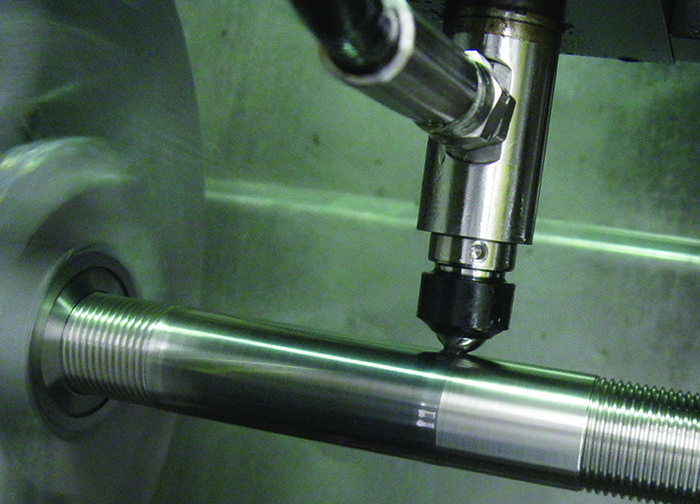Extending the Strength and Life of Tie Rod Bolts
Turbines are the backbone of power generation, so maintaining top performance of all their moving parts is important for continued, efficient operation. Tie rod bolts that connect gas turbine stages are susceptible to fretting fatigue at the edge of the contact region between the turbine rotors and the tie rod landings. Oxide particles can become embedded in the surfaces at these locations, creating local stress concentrations. Shallow shear cracks formed at the edge of fretting zones can initiate fatigue cracking, potentially leading to failure within the first few years of service.
 |
|
1. Tie rod bolts that connect the stages of gas turbines are susceptible to fretting fatigue at the edge of the contact region between the turbine rotors and the tie rod landings. Courtesy: Lambda Technologies Group |
Plant operators frequently inspect the tie rod bolts to address this problem, replacing bolts that have signs of damage. Replacing a set of 12 bolts can cost upward of $400,000, not including the substantial downtime that impacts operating efficiency and costs of power generation. A leading company in the transmission and generation of power approached Lambda Technologies with an important project: assist them in devising a solution to increase the fatigue strength of the tie rod bolts (Figure 1) without changing either the material or the design.
The Benefits of Compressive Stress
Lambda proposed introducing residual compression into the edge of the contact region of the tie rod bolts. The benefits of compressive residual stress are well-known in engineering circles, because it reduces the effects of applied tensile stresses. Beneficial residual compression can be introduced through surface treatments such as shot peening, laser shock peening, deep rolling, and low plasticity burnishing (LPB).
In this instance, LPB was chosen for its repeatability and ease of application using conventional computer numerical control (CNC) machine tools. The highly controlled nature of the process allowed Lambda engineers to sculpt the compression to the optimum levels for the tie rod bolts.
LPB is a mechanical process that applies a designed residual stress field to the surface of metal components to produce a deep, stable layer of beneficial residual compression. The depth, magnitude, and distribution of the compression are designed specifically for each application to provide maximum resistance to foreign objects, corrosion fatigue, fretting, stress corrosion cracking, and other common damage mechanisms. The process is well-recognized in aerospace applications, but not as commonly used in the power industry.
The military has used LPB for repairs on aircraft such as the AV-8B Harrier II and the P-3 Orion. The LPB process also has an Alternative Method of Compliance (AMoC) certification from the Federal Aviation Administration, and Delta Airlines contracted with Lambda to treat shock-strut cylinders for its MD-88 aircraft.
Putting Designed Compression to the Test
Every job requires an engineering phase, analyzing the material, then measuring the residual stress. LPB is performed using a wheel or ball tool to roll across the surface of the tie rod bolt, applying compression in a single, highly controlled pass. Limiting the number of instances where the tool comes in contact with the surface keeps cold work low, allowing the imparted stresses in the bolts to remain stable in high temperatures. In this application, LPB was applied using a Haas CNC lathe.
 |
|
2. This chart shows the typical benefits derived from low plasticity burnishing (LPB) surface treatment of tie rod bolts, compared to untreated bolts. Courtesy: Lambda Technologies Group |
Fatigue tests (Figure 2) were conducted on the LPB-treated and untreated tie rod bolts with simulated conditions of fretting and embedded oxide particles. The tie rod material deteriorated by a factor of five in the untreated rods. The LPB-treated rods saw more than a six-fold improvement in fatigue strength even with oxide damage and fretting.
Additional combined thermal-mechanical tests for years of thermal exposure with nominal operating stresses proved that the LPB-induced compressive residual stresses remained stable during operation. The testing results confirmed that the benefits of LPB treatment would allow the tie rod bolts to resist fretting fatigue for the duration of the designed life of the gas turbines they hold together.
Dollars and Sense
More than 160 tie rod bolts have been processed with LPB at Lambda Technologies’ Cincinnati, Ohio, facility, resulting in 14 sets of bolts that will never need replacing and a savings of $5.6 million to the customer in materials alone. Adding the cost of taking the gas turbines out of service for repairs, estimated at about $1 million per shutdown, yields nearly $20 million in savings at the time of this writing.
When damaged mechanisms are impacting component performance, surface enhancement techniques to impart designed compression are a cost-effective solution to ensure reliable performance.
—N. Jayaraman, PhD is a Fellow Emeritus at Lambda Technologies Group, where he previously served as Director of Materials Research.